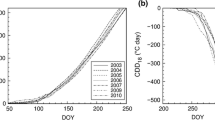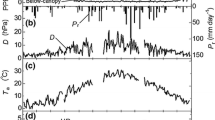Abstract
To explain why the composition of evergreen and deciduous forests changes along air temperature gradients, we measured several traits of single leaves from temperate deciduous and evergreen broadleaf trees with simultaneous and successive leaf emergence growing at different altitudes in the field. The parameters included seasonal net photosynthetic rate, longevity, mass per area, nitrogen content, and photosynthetic nitrogen-use efficiency. With decreasing altitude, the leaf longevity of deciduous broadleaf trees increased, whereas the maximum net photosynthetic rate decreased. In contrast, leaf longevity of evergreen broadleaf trees decreased, whereas the minimum net photosynthetic rate in winter increased. Along the air temperature gradient, the annual production of deciduous trees with simultaneous leaf emergence may be constant, because the integrated lifetime net photosynthetic rate (ILNPR) of a single leaf changed little. In comparison, deciduous trees with successive leaf emergence may show enhanced annual production with increasing air temperature, by increasing the total leaf number per branch and tree under an extended growing season. Temperate evergreen broadleaf tree species may also show increased annual production with increasing air temperature by sufficiently raising the number of the first-year leaves to the total leaves of branch and tree, which is accelerated by raising the integrated first-year net photosynthetic rate of the single leaf, despite little change in the ILNPR. With increasing air temperature from cool-temperate to warm-temperate zones, evergreen broadleaf tree species gain an advantage of the annual production over deciduous broadleaf tree species with simultaneous leaf emergence.







Similar content being viewed by others
References
Aiba S, Hanya G, Tsujino R, Takyu M, Seino T, Kimura K, Kitayama K (2007) Comparative study of additive basal area of conifers in forest ecosystems along elevational gradients. Ecol Res 22:439–450
Berg EE, Chapin FS III (1994) Needle loss as a mechanism of winter drought avoidance in boreal conifers. Can J For Res 24:1144–1148
Berry J, Björkman O (1980) Photosynthetic response and adaptation to temperature in higher plants. Ann Rev Plant Physiol 31:491–543
Bruhn D, Leverenz JW, Save H (2000) Effects of tree size and temperature on relative growth rate and its components of Fagus sylvatica seedlings exposed to two partial pressures of atmospheric CO2. New Phytol 146:415–425
Chabot BF, Hicks DJ (1982) The ecology of leaf life span. Annu Rev Ecol Syst 13:229–259
Eguchi T (2006) Climatic characteristics around the mountaintop. In: Ohsawa M, Tagawa H, Yamagaiwa J (eds) A world heritage: Yakushima Island—nature and ecosystem of the subtropics. Asakurashoten, Tokyo, pp 11–17 (in Japanese)
Field C, Mooney HA (1986) The photosynthesis–nitrogen relationship in wild plants. In: Givnish TJ (ed) On the economy of plant form and function. Cambridge University Press, Cambridge, pp 25–55
Gower ST, Reich PB, Son Y (1993) Canopy dynamics and aboveground production of five tree species with different leaf longevities. Tree Physiol 12:327–345
Grunderson CA, Norby RJ, Wullschleger SD (2000) Acclimation of photosynthesis and respiration to stimulated climatic warming in northern and southern populations of Acer saccharum: laboratory and field evidence. Tree Physiol 20:87–96
Hikosaka K, Hirose T (2000) Photosynthetic nitrogen-use efficiency in evergreen broad-leaved woody species coexisting in a warm-temperate forest. Tree Physiol 20:1249–1254
Hikosaka K, Nagamatsu D, Ishii HS, Hirose T (2002) Photosynthesis–nitrogen relationships in species at different altitudes on Mount Kinabalu, Malaysia. Ecol Res 17:305–313
Kikuzawa K (1983) Leaf survival of woody plants in deciduous broad-leaf forests. 1. Tall trees. Can J Bot 61:2133–2139
Kikuzawa K (1988) Leaf survival of tree species in deciduous broad-leaved forests. Plant Species Biol 3:67–76
Kikuzawa K (1991) A cost–benefit analysis of leaf habit and leaf longevity of trees and their geographical pattern. Am Nat 138:1250–1263
Kikuzawa K (1996) Geographical distribution of leaf life span and species diversity of trees simulated by a leaf-longevity model. Plant Ecol 122:61–67
Kikuzawa K, Lechowitz MJ (2006) Toward synthesis of relationships among leaf longevity, instantaneous photosynthetic rate, lifetime leaf carbon gain, and the gross primary production of forests. Am Nat 168:373–383
Kikuzawa K, Lechowitz MJ (2011) Ecology of leaf longevity. Springer, Tokyo
Kikuzawa K, Shirakawa H, Suzuki M, Umeki K (2004) Mean labor time of a leaf. Ecol Res 19:365–374
Koike T (1988) Leaf structure and photosynthetic performance as related to the forest succession of deciduous broad-leaved trees. Plant Species Biol 3:778–799
Koike T (1990) Autumn coloring, photosynthetic performance and leaf development of deciduous broad-leaved trees in relation to forest succession. Tree Physiol 7:21–32
Kudo G (1992) Effect of snow-free duration on leaf life-span of four alpine plant species. Can J Bot 70:1684–1688
Kudo G (1995) Leaf traits and shoot performance of an evergreen shrub, Ledium palustre ssp. decumbens, in accordance with latitudinal change. Can J Bot 73:1451–1456
Kudo G (1996) Intraspecific variation of leaf traits in several deciduous species in relation to length of growing season. Ecoscience 3:483–489
Kusumoto T (1978) Photosynthesis and respiration in leaves of main component species. In: Kira T, Ono Y, Hosokawa T (eds) Biological production in a warm-temperate evergreen oak forest of Japan JIBP SYNTHESIS, vol. 18. University of Tokyo, Tokyo, pp 88–98
Lewis JD, Olszyk D, Tingey DT (1999) Seasonal patterns of photosynthetic light response in Douglas-fir seedlings subjected to elevated atmospheric CO2 and temperature. Tree Physiol 19:243–252
Mediavilla S, Escudero A (2003) Photosynthetic capacity, accumulated over the lifetime of a leaf, is predicted to be independent of leaf longevity in some tree species. New Phytol 159:203–211
Menzel A, Fabian P (1999) Growing season extended in Europe. Nature 397:659
Monsi M, Saeki T (1953) Über den Lichtfackor in den Pflanzengesellschaten und seine Bedeutung für die Stoffproduktion. Jpn J Bot 14:22–52
Nomoto N (1964) Primary productivity of beech forest in Japan. Jpn J Bot 18:385–421
Ohsawa M (1990) An interpretation of latitudinal patterns of forest limits in south and east Asian mountains. J Ecol 78:326–339
Reich PB, Uhl C, Walters MB, Ellsworth DS (1991) Leaf life span as a determinant of leaf structure and function among 23 tree species in Amazonian forest communities. Oecologia 86:16–24
Reich PB, Walters MB, Elsworth DS (1992) Leaf life-span in relation to leaf, plant, and stand characteristics among diverse ecosystems. Ecol Monogr 62:365–392
Ruel JJ, Ayres MP (1996) Variation in temperature responses among populations of Betula papyrifera. Silva Fennica 30:145–158
Saxe H, Cannell MGR, Johnson Ø, Ryan MG, Vourlitis G (2001) Tree and forest functioning in response to global warming. New Phytol 149:369–399
Selaya NG, Anten NP (2010) Leaves of pioneer and later-successional trees have similar lifetime carbon gain in tropical secondary forest. Ecol 91:1102–1113
Suzuki E (1997) The dynamics of old Cryptomeria japonica forest on Yakushima Island. Tropics 6:421–428
Takada T, Kikuzawa K, Fujita N (2006) A mathematical analysis of leaf longevity of trees under seasonally varying temperatures, based on a cost–benefit model. Evol Ecol Res 8:605–615
Tang CO, Ohsawa M (1999) Altitudinal distribution of evergreen broad-leaved trees and their leaf-size pattern on a humid subtropical mountain, Mt. Emei, Sichuan. China Plant Ecol 145:221–233
Teskey RO, Will R (1999) Acclimation of loblolly pine (Pinus taeda) seedlings to high temperatures. Tree Physiol 19:519–525
Walter H (1973) Vegetation on the earth in relation to climate and the eco-physiological conditions. Springer, New York
Walther G-R (2002) Weakening of climatic constraints with global warming and its consequences for evergreen broad-leaved species. Folia Geobot 37:129–139
Walther G-R, Post E, Convey P, Menzel A, Parmesan C, Beebee TJC, Fromentin J-M, Hoegh-Guldberg O, Bairlein F (2002) Ecological responses to recent climate change. Nature 416:389–395
Wang KY, Kellomaki S, Laitinen K (1995) Effect of needle age, long-term temperature and CO2 treatments on the photosynthesis of Scots pine. Tree Physiol 15:211–218
Wang KY, Kellomaki S, Laitinen K (1996) Acclimation of photosynthetic parameters in Scots pine after three years exposure to elevated temperature and CO2. Agric For Meteorol 82:195–200
Way DA, Oren R (2010) Differential responses to changes in growth temperature between trees from different functional groups and biomes: a review and synthesis of data. Tree Physiol 30:669–688
Welp LR, Randerson JT, Liu HP (2007) The sensitivity of carbon fluxes to spring warming and summer drought depends on plant functional types in boreal forest ecosystems. Agric For Meteorol 147:172–185
Yim Y, Kira T (1975) Distribution of forest vegetation and climate in the Korean Peninsula. I. Distribution of some indices of thermal climate. Jpn J Ecol 25:77–88
Author information
Authors and Affiliations
Corresponding author
About this article
Cite this article
Fujita, N., Noma, N., Shirakawa, H. et al. Annual photosynthetic activities of temperate evergreen and deciduous broadleaf tree species with simultaneous and successive leaf emergence in response to altitudinal air temperature. Ecol Res 27, 1027–1039 (2012). https://doi.org/10.1007/s11284-012-0983-z
Received:
Accepted:
Published:
Issue Date:
DOI: https://doi.org/10.1007/s11284-012-0983-z




